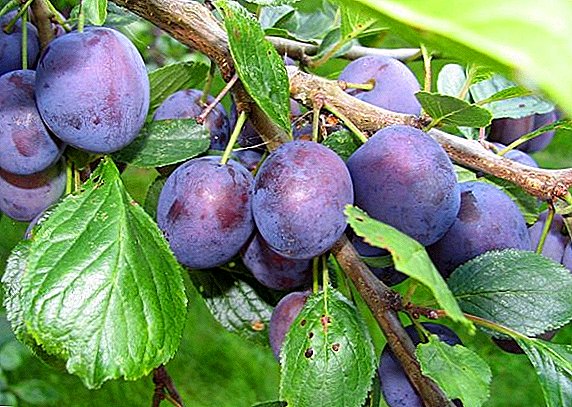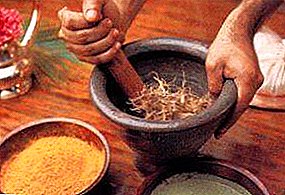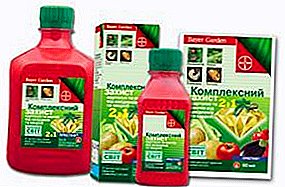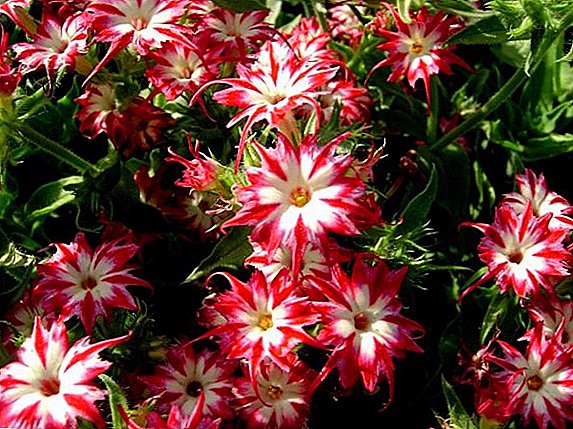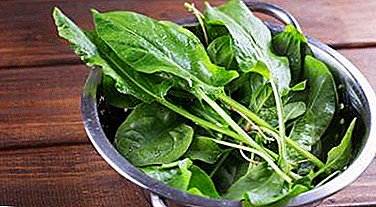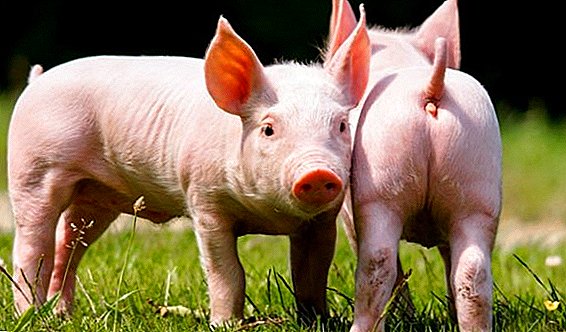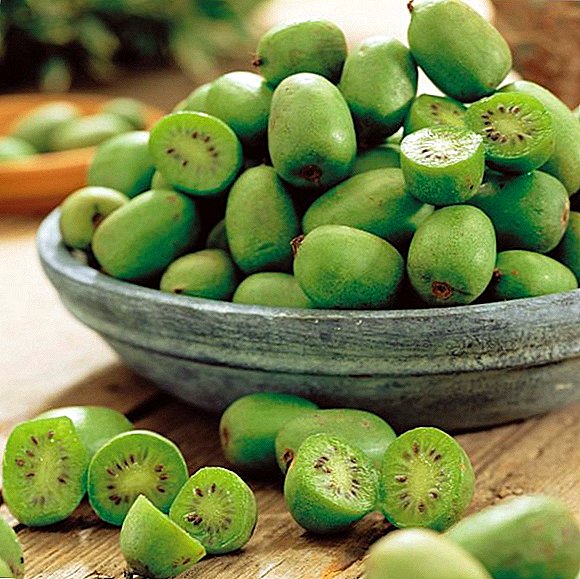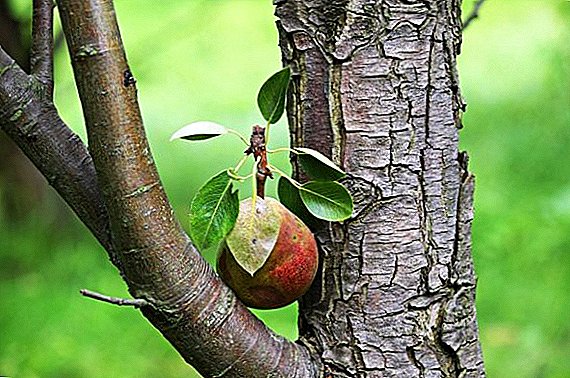
Beautiful pear fruits bring a feeling of rapid saturation and delight with their pleasant taste and pronounced aroma.
One of the most popular is the variety of pears "Nika", more about which we will discuss in this article.
Description of pear varieties "Nika"
The height of the tree varieties "Nick" average, and the growth rate itself - the average. The crown of the tree is round in shape with rare, firmly fused branches. The shoots of a tree of this variety are brown in color with a smooth texture. Leaves rich green color, smooth with a glossy shine.
Fruits are rather large in size, the weight of the fruit of the Nika pear reaches 200 g. The fruit is a truncated conical streamlined shape. The skin of the fruit is of medium density, with a smooth texture and glossy shine, which is provided by a waxy coating.
 The color of the fruit varies from the degree of maturity: for example, during the period of removable maturity, the color is green-red with a predominance of green; during consumer maturity - yellow-red with a predominance of red with a brownish tinge.
The color of the fruit varies from the degree of maturity: for example, during the period of removable maturity, the color is green-red with a predominance of green; during consumer maturity - yellow-red with a predominance of red with a brownish tinge.
The fruit is kept on a short curved stem that is located in a small, narrow funnel. The flesh is fine-grained, juicy, not granulated, with a sweet-sour taste and a pleasant aroma.
The chemical composition of the variety "Nika":
- the total amount of sugars - 10.2%;
- Vitamin P - 122 mg / 100 g;
- Vitamin C - 6.2 mg / 100 g;
- dry substances - 15.7%;
- titrated acids - 0.40%.
Pros and cons varieties
One of the main advantages of the variety is a stable and fairly abundant yield of pear "Nika". The first fruits on the tree appear 5-6 years after planting.
The undeniable advantage of the Nika pear is the high frost resistance of the tree, which makes it attractive for growing in almost all regions of the country. An important fact in favor of the cultivation of this fruit tree is a good transportability of Nick pear.
Did you know? Grade pears "Nika" is well restored even after frost down to -38 ° C, and the damage is only 0.6 points.
 Another positive feature of the Nika pear variety is its good disease resistance, as well as a very high-quality dessert taste.
Another positive feature of the Nika pear variety is its good disease resistance, as well as a very high-quality dessert taste.
The disadvantages of this variety are much less than the merits among them, partial self-fertility of the variety, the need for regular pruning, as well as the rather slow period of ripening of the fruit of the Nika pear.
How to choose a seedling when buying
Often we have to buy fruit trees in stores or in flower markets. In order for seedlings of pear varieties "Nika" to take root well, it is necessary to choose them correctly.
The first thing you need to pay attention to is the appearance of the seedling: it should be clean and in no case should have any signs of dryness or lethargy.
Important! A note should be attached to each seedling with information about the breeder firm, variety, breed and description of the favorable area for cultivation; if there is no such tag, it is better to refuse to purchase a sapling: most likely, it is of poor quality.
 A good seedling has at least five main and three additional roots with a length of at least 30 cm. The roots of a quality seedling must be bright, clean, without growths, spots and signs of rot.
A good seedling has at least five main and three additional roots with a length of at least 30 cm. The roots of a quality seedling must be bright, clean, without growths, spots and signs of rot. It is better to buy seedlings that have turned no more than 2 years old; it is quite simple to find out such: they have not fully formed the crown.
How to choose and prepare a place for a pear
The quality and quantity of the pear harvest depends to a greater extent on the observance of the rules of agrotechnology of the pear variety "Nika". These rules begin with the selection and preparation of a place for planting a pear.
Did you know? The pear does not like to “move” from place to place, therefore, when planting seedlings, it is necessary to choose the most suitable place so that you do not have to repot the tree.Many consider that a pear is an exclusively southern plant, and they strive to ensure that the tree grows in a place completely protected from the wind, therefore they plant a tree between rooms in the yard or, taking into account the average size of the Nika pear, between higher and larger trees.
This is wrong, because in the shade the growth of a pear can slow down and the quality of the harvest will decrease. For pear varieties "Nika" is best to choose a well-lit, sunny, well-warmed place.
 It is important that the pear grows in a free, rather large area, because, despite the average size of the tree, it needs quite a lot of space for full development.
It is important that the pear grows in a free, rather large area, because, despite the average size of the tree, it needs quite a lot of space for full development.
Before planting a pear, you need to prepare a place for it. Start doing this in a week after landing. The diameter of the pit for planting should be at least 1 meter, and the depth - 70-80 cm.
When digging a hole, it is better to leave the upper ground: it will be needed for planting a tree, while the deep earth will not be useful. Before you begin the process of planting, the earth is fed with potash-phosphate fertilizers and organic matter in the right ratio.
Fertilizers are connected to the ground, dug from above, and fall asleep in a hole. This substrate is poured with a solution of hydrated lime (2 cups per 10 liters of water). In this form, the pit is left for a week.
Step-by-step process of planting seedlings
The best time for planting seedlings will be the end of September - the beginning of October (the pear will have time to adapt and gain strength before the cold weather) or the end of April - the beginning of May (until the leaves start to bloom).
Planting pear varieties "Nika" is best done in a pair with someone, because the process is quite simple, but you need to do everything in a complex.
Important! Before planting, it is necessary to drive a pole about a meter long in order to properly form the trunk and crown of a young tree.So, planting seedling algorithm:
 Pour the earth into the pit in such a way that a small mound is formed;
Pour the earth into the pit in such a way that a small mound is formed;- To plant a seedling and gently, without damaging, straighten the roots;
- Fill the root system with soil so that the root neck is visible 4-6 cm;
- Lightly tamp the ground around the seedling;
- Pour an earthen bank around the pit so that the planted tree is inside the hole, which is useful for watering;
- Water the seedling with 2-3 buckets of water;
- The trunk of the seedling must be tied to the pole with a rope, having previously wrapped the bark with rubber so that the rope does not grow into the tree;
- The next day, rumble the soil with humus.
Features care for pear varieties "Nika"
Caring for a pear "Nika" involves the correct watering, timely feeding, as well as high-quality pruning of the tree. If you do it right, you will get a beautiful decoration to your garden and a delicious dessert to the table.
How to conduct watering pear "Nika"
Especially careful and abundant watering tree requires immediately after planting. The seedling is watered often until the roots take root to the end. In summer, the tree is watered once a month.
 It is impossible to pour water directly under the tree, otherwise the roots will be washed away and the pear will die. It is better to dig a small ditch around the tree and pour water into the trench. For irrigation, it is better to use warmed-up separated water, because a tree can get sick from a sharp stream of cold water.
It is impossible to pour water directly under the tree, otherwise the roots will be washed away and the pear will die. It is better to dig a small ditch around the tree and pour water into the trench. For irrigation, it is better to use warmed-up separated water, because a tree can get sick from a sharp stream of cold water.
In order to avoid the formation of a crust around the tree, after watering the soil is better loosened, in addition, thanks to this procedure, the roots will breathe better.
What and when to feed pears
The root system of the pear is hidden quite deeply, and therefore the feeding of the Nika pear is often superficial. When planting, the tree is fertilized for the first time, bringing organic fertilizer into the pit.
The following feeding is carried out in the fall. During this period, manure and compost are used and they mulch the soil around the tree.
Did you know? For better penetration of nutrients into the roots of the pear around it, you can make small holes and pour the solutions with fertilizer into them.
 In the spring and summer, during the period of the most active growth of the tree, the pear needs a large amount of nitrogen, which contributes to the development of the tissues of the tree. In June, potash substances and phosphorus can be added to the soil - this will strengthen the wood.
In the spring and summer, during the period of the most active growth of the tree, the pear needs a large amount of nitrogen, which contributes to the development of the tissues of the tree. In June, potash substances and phosphorus can be added to the soil - this will strengthen the wood.
If the soil in your area is acidic, from time to time it is necessary to feed the pear with preparations containing calcium, or lime or ashes can be used as a substitute. With solutions of these substances it is necessary to water a tree.
Literate pruning pears
The first pruning is performed when the tree is already 1 year old. At this point, the young tree is cut in such a way that it reaches no more than 50 cm in height. This activates the growth of the lower branches.
At 4-5 years of growth, the crown of the pear is thinned to improve access to light and the branches are shortened to give the crown a beautiful regular shape.
Pruning should be done with a very sharp object, “on the ring,” and only those branches that grow incorrectly and shade the rest should be removed. All places of cuts must be lubricated with garden pitch or special putty.
Important! If you do not carry out timely pruning, the shoots will become bare, and the fruits will significantly decrease in size.
When to harvest and how to store the harvest of pear varieties "Nika"
Sort "Nika" refers to winter varieties of pears and that is why it is very attractive for cultivation in the garden plot, despite its "youth." The optimal time for picking fruit is the end of September - the beginning of October.
It is important not to overdo the pears on the tree, so that they do not over-sleep and are better kept. Better stored fruit collected in the period of removable maturity, the color of which is green-brown.
An important sign of the "readiness" of the fruit to be harvested is that it easily detaches from the stem. A sign of ripeness will also be the elasticity of the pear: if the fruit becomes soft, it will not be stored.
It is better to keep NIKA pears in a cool visit with high humidity. In a special container (it is better to use boxes made of natural materials) lay out paper or shavings on the bottom, and on top - fruits in a staggered way or diagonally.
During the storage of pears, it is necessary from time to time to “examine” the fruits, and if you notice rot or damage, these pears must be picked up from the common box.
Preparing for winter young seedlings
 Despite the fact that the pear "Nika" tree is frost-resistant, young saplings need shelter. At the end of October, the tree must be covered with a layer of mulch, it will “warm” the root system. For this, straw, sawdust or humus will do.
Despite the fact that the pear "Nika" tree is frost-resistant, young saplings need shelter. At the end of October, the tree must be covered with a layer of mulch, it will “warm” the root system. For this, straw, sawdust or humus will do.
With the onset of frost, you need to cover the pear trunk with agrotextile - a special fabric that perfectly passes moisture and light, and also has a "heating" effect. From above, the seedling needs to be covered with snow, and the more snow you put on the seedling (of course, not so much as to cover the tree with the top), the warmer the pear will be.
If you do not have agrotextiles, you can use fir branches. The youngest and lowest shoots can be bent to the ground, the snow will “shelter” them, and this will increase the quality and quantity of the crop.
Resistance of pear varieties "Nika" to diseases and pests
“Nika” is very rarely ill, and if some preventive measures are taken, then there will be no problems at all.
Preventive actions:
- In time to make mineral fertilizers and organic matter, it will help the tree to become stronger and easier to endure all possible diseases.
- Do not overmoisten the soil, because a moist environment contributes to the development of fungal microorganisms.
- Timely pruning and cleaning near the tree. This will save the plant from possible parasites and fungi that live in heaps of leaves and on diseased shoots.
- Lime whitewash that protects the tree from insects.
 If you have already noticed the first signs of disease: spots and brows on the leaves, damage on the shoots and kidney rot, you must treat the tree with fungicides and repeat the treatment after 7 days.
If you have already noticed the first signs of disease: spots and brows on the leaves, damage on the shoots and kidney rot, you must treat the tree with fungicides and repeat the treatment after 7 days.
If you notice a white bloom or a spider web on the inside of the leaf, the pear must be treated with insecticides. Also in the fight against insects in the first stages will help the soap solution, they need to spray the plant.
As you know, a pear can bear fruit for about 100 years. Pear varieties "Nika" - unpretentious and very attractive for growing in the garden tree, and therefore now that you have learned the basic rules of growing a tree and will stick to them, your tree will delight you for many years.


 Pour the earth into the pit in such a way that a small mound is formed;
Pour the earth into the pit in such a way that a small mound is formed;
